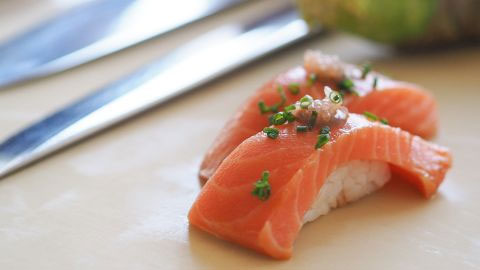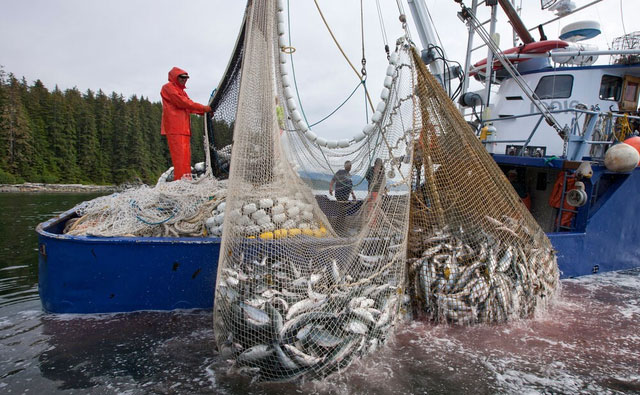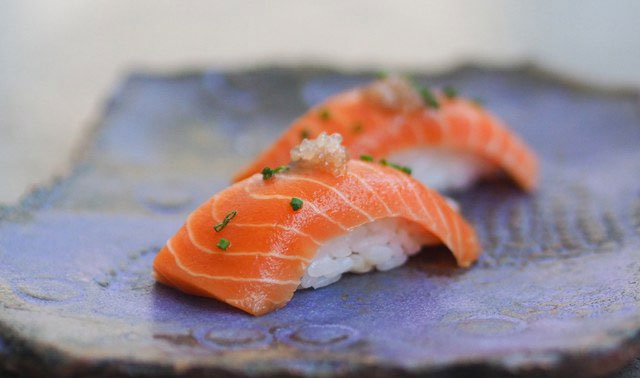Lab-grown seafood products are gaining popularity among many, including the famous actor from Titanic, Leonardo DiCaprio.
Homegrown Fish: No Catching or Farming Required
In the heart of San Francisco, California, there is a special seafood production facility called Wildtype. This facility specializes in producing salmon for sushi, but not in the conventional way; instead, they produce cell-cultured salmon.

Lab-grown salmon product.
The cultivation process begins with a small sample taken from a living fish, which is then cultured in stainless steel tanks similar to those used in breweries. The result of this process is delicious fish fillets.
This type of fish that is not really fish could be a crucial link for the future of the seafood production industry. While plant-based seafood products account for only 0.1% of the 1.4% market share for plant-based meat alternatives, cell-cultured fish seems to be a significant target for venture capitalists.
Several companies have been established to research this unique product, including BlueNalu, based in San Diego, which has raised $84.6 million since its inception in 2018, and Wildtype, which secured $100 million thanks to funding from private businesses and venture capitalists, including the renowned actor Leonardo DiCaprio.

Actor Leonardo DiCaprio, investor in seafood cultivation project.
Proponents of this cultivation method believe that it is a solution to many marine environmental issues, particularly overfishing. Additionally, lab-grown seafood can help consumers avoid health risks associated with mercury and microplastics found in wild fish. While traditional seafood distribution often involves 10 to 15 intermediaries before reaching consumers, with this “artificial” fish, eaters will know exactly where their product comes from.
Justin Kolbeck, co-founder and CEO of Wildtype, who is also a former official dealing with food security issues abroad, expressed concern that current natural seafood sources will not meet the consumption demands of a rapidly growing population.
He stated: “The scale of seafood harvesting is so vast that if this project fails, not only will we be at risk, but other species will be too. We cannot wait until the last moment; we need to act now while the oceans can still recover.”

Overfishing is depleting seafood resources.
Lou Cooperhouse, founder and CEO of BlueNalu, stated: “We are creating an environmental disaster due to the unprecedented disruption of the seafood supply chain, and seafood consumption is at an all-time high.”
Currently, BlueNalu is focusing on developing bluefin tuna products. Mr. Cooperhouse announced that his company is ready to scale up and believes that within the next 10 years, similar factories will be built worldwide to meet consumer demand.
A sustainable seafood source is an urgent need to meet a growing population projected to reach 10 billion by 2050. While plant-based meats are currently attracting attention, cultivated meats are expected to appear on the dining tables of every household within the next two years.
Some Skepticism
However, critics argue that for cell-cultured products to replace wild-caught or farmed seafood, producers must make them competitively priced and convince consumers to switch from natural seafood.
Moreover, the quantity of seafood produced must be large enough to replace wild-caught fish. In reality, this hypothesis is challenging to achieve because even the amount of “farmed” fish only supplements rather than replaces wild-caught seafood.
“I am really skeptical about claims that cultivated seafood companies will make a difference in the seafood industry and ocean conservation,” said Benjamin Halpern, a marine biologist at the University of California.
California is the state with the largest investment in research on alternative meat products compared to any other state in the U.S. Approximately $5 million has been funded to three University of California campuses: UC Berkeley, UC Davis, and UCLA. Additionally, the Biden administration is also supporting cell-cultured meat through a recent executive order.

We cannot be sure if consumers will accept this type of fish.
When produced in a lab, seafood such as salmon and tuna can be optimized for flavor, texture, and nutritional content, ensuring that users can cook or eat it raw like sushi. However, we cannot be certain if consumers will accept this type of fish.
Marika Azoff, an expert from the Good Food Institute, a non-profit organization promoting the use of alternative protein sources, stated: “Consumers need products that taste similar to or even better than the original products, at a lower price and more widely available.”
Even those who were once skeptical about cell-cultured methods must admit that cultivated seafood has significant market potential, but it will always be a costly item, even as prices gradually decrease over time. This may make it less accessible to consumers, especially since salmon and tuna are not among the endangered species.
Halpern from the University of California, Santa Barbara, noted: “This product is providing the wealthy with another option. Even at the lowest possible price, it is not food that people will choose for their daily consumption.”
Future Potential
Recently, BlueNalu announced that they have discovered the golden key to pricing issues, enabling them to achieve significant profitability for their first large-scale factory. The key issue lies in technologies that will help reduce operational and capital costs. Combined with a premium product brand and targeted customer identification, this business could achieve gross profits of up to 75%.
Rob Jones, CEO of the environmental organization Nature Conservancy, stated: “I clearly see the role of alternative seafood in providing sustainable food sources, similar to how I selectively harvest and farm seafood. Both cell-cultured seafood and plant-based seafood can be part of the future.”

In the future, alternative seafood will be a source of sustainable food.
Additionally, Mr. Jones shared that alternative seafood products could capture 1% to 2% of the overall market, similar to plant-based meats, provided that the environmental and social impacts of the production process, such as carbon emissions and raw material supply, are taken into account.
Most producing companies will not share their intellectual property, and currently, we do not fully understand the efficacy of this cultivation. BlueNalu compares its method to the brewing process, emphasizing that the current seafood industry is overly resource-intensive.
Traditional fishing methods require large amounts of resources such as labor on boats, oil, and large transportation vehicles, but only achieve efficiency levels of 50% to 70% depending on the species.
The two leading companies in cell-cultured seafood production, BlueNalu and Wildtype, state that there is no single solution to meet the world’s seafood demand, but they believe that the presence of this new method can ensure greater sustainability in the industry. Their main role is to support the transition from traditional methods in the current context.


















































